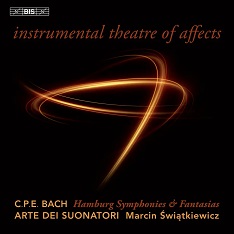1768 hatte Carl Philipp Emanuel Bach seinen Posten am Hofe Friedrichs II. in Berlin aufgegeben und war nach Hamburg umgezogen, wo er die Nachfolge seines Taufpaten Georg Philipp Telemann antrat und musikalisch regelrecht aufblühte. Das äußert sich z.B. in den sogenannten 6 Hamburger Sinfonien, über die Dirigent Riccardo Minasi einmal sagte: « Die sechs Sinfonien, die Bach für van Swieten komponiert hat, sind absolut verrückt. Man kann förmlich in jedem Takt Bachs Absicht spüren, sich als ‘enfant terrible’, als rebellischer Sohn (filio rebel) zu gerieren. Er versucht, sich selbst auf die exzentrischste Art und Weise zu präsentieren. Er hat große Mühe darauf verwendet, jeden möglichen musikalischen Affekt zu zeigen. »
Dieses ‘Instrumental theatre of affects’ (so lautet der Titel des vorliegenden Albums von BIS) zeigt das sehr gut. Arte dei Suonatori treibt die Absichten des Komponisten auf die Spitze in zupackenden, hoch dramatischen Interpretationen dieser hoch virtuosen, frühklassizistischen Sinfonien mit ihren bizarren Brüchen und ihren unkonventionellen oft überraschenden Ausdrucksformen.
Dazwischen zeigt Marcin Swiatkiewicz am Cembalo, warum C.P.E. Bach als der größte Cembalist seiner Zeit galt. Es sind nicht nur die Virtuosität und das Farbenspektrum, die hier faszinieren, sondern die Expressivität und Rhetorik, die der Cembalist erreicht.
In 1768, Carl Philipp Emanuel Bach left his post at the court of Frederick II in Berlin and moved to Hamburg, where he followed in the footsteps of his godfather Georg Philipp Telemann and flourished musically. This can be seen, for example, in the so-called 6 Hamburg Symphonies, about which the conductor Riccardo Minasi once said: « The six symphonies that Bach composed for van Swieten are absolutely crazy. You can literally feel in every bar Bach’s intention to act like an ‘enfant terrible’, a rebellious son (filio rebellius). He tries to present himself in the most eccentric way. He goes out of his way to show every possible musical affect.
This « instrumental theater of affects » (the title of this album by BIS) shows this very well. Arte die Suonatori pushes the composer’s intentions to the extreme in gripping, highly dramatic interpretations of these highly virtuosic early classical symphonies, with their bizarre breaks and unconventional, often surprising forms of expression.
In between, Marcin Swiatkiewicz demonstrates on the harpsichord why C.P.E. Bach was considered the greatest harpsichordist of his time. It is not only the virtuosity and range of colors that fascinate, but also the expressiveness and rhetoric that the harpsichordist achieves.

















